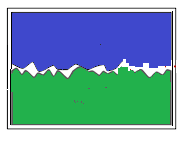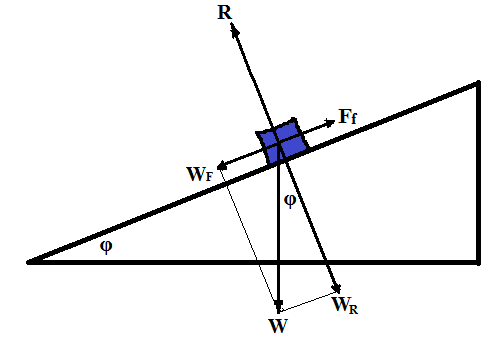Notes to a video lecture on http://www.unizor.com
Friction
What's good and bad about friction?
Friction prevents us to easily move furniture around. We can buy special
devices to make it easier, but friction is definitely prevents to move
furniture easily.
Friction is the reason why parts in many machines wear out and need replacement.
Friction between the air and a spaceship, when it enters the atmosphere,
causes tremendous heating of the spaceship's body and requires special
layer of heat-resistant material to cover the spaceship.
Friction prevents a rollerblader to roll indefinitely along the smooth straight road.
In a word, friction is bad.
But is it really?..
Friction is needed to walk on a road, to drive a car, to wear clothes,
to have furniture in place where we want it, to have plates on a table
in a steady position without slipping over the edge, to fork a piece of
meat, to hold a glass of water in a hand.
Enough! As we see, we cannot live without friction, but sometimes would like to reduce it.
So, what is friction?
Here is what causes friction:

On a micro level the surfaces of two objects touching each other are not
perfect. Each little bump of one is catching a little bump of another,
thus preventing smooth gliding of one surface over another.
As was mentioned above, there are good and bad sides of this story, but
it is what it is. We have to use this friction, when needed, and reduce,
when desired.
Static Friction
Static friction is the friction between an object at rest and surface it is positioned on.
A chair stands at a fixed place on a floor, even if the floor is slightly tilted, because static friction holds it in place.
Micro-bumps on the floor are caught in-between micro-bumps on the chair's legs and fix the chair's position on a floor.
Friction is the source of the force preventing the motion. If there is
no force that attempts to move an object from the position of rest,
friction results in no force preventing this move, but, if there is a
force that attempts to move an object, friction exhorts a force against
it, thus preventing the move.
If the force that attempts to move an object is not too strong, bumps on
the surfaces of object and its support are still caught between each
other, an object stays in place, which means that the force of friction,
directed against the force that attempts to move an object, is equal to
a force of moving by magnitude and opposite in direction.
Obviously, the force of friction has its limits, so, if a very strong
force attempts to move an object, the bumps on the surface will no
longer be able to hold an object, and an object moves.
So, as the force attempting to move an object from the state of rest
grows in magnitude, so does a force of static friction that prevents
this move, but only up to a maximum value, after which the force of
friction cannot grow any more, and the object moves. This maximum value of the friction force is the one when it is specified explicitly.
To move an object from the position of rest we have to apply force. The
heavier an object - the deeper bumps on its surface are caught
in-between bumps of the surface it stands on. Therefore, the force
needed to move it from the position of rest depends on an object's
weight. At the same time, surfaces can be more or less smooth, that is
they can have deeper or shallower bumps. Obviously, the degree of
smoothness must be a factor in the amount of force needed to move an
object from the position of rest.
So, two major factors contribute to the amount of force needed to shift
an object from the position of rest: the pressure between an object and a
surface it stands on (for example, the component of its weight) and the
quality of surfaces of an object and its support.
According to numerous experiments, for any two surfaces (surface of an object and surface of a support it rests on) there is a coefficient of static friction μ, such that the force needed to shift an object from the position of rest F depends on this coefficient and the normal pressure N between an object and its supporting surface as
F = μ·N
If the experiment is conducted on Earth and the supporting surface is horizontal, normal pressure of an object is its weight.
If the surface is an incline, the vector of weight should be represented
as a combination of a normal to a supporting surface and tangential to
it components. The normal component contributes to friction, while the
tangential component represents the force that attempts to move object
from the position of rest.
Consider an incline of angle φ and an object of weight W on it. Will it slide down?

The following forces are acting upon this object:
(a) vector of gravity of Earth W directed vertically down;
(b) reaction of the surface R directed perpendicularly to a surface of an inclined;
(c) force of static friction Ff directed against potential movement down the slope.
The right approach to analysis of this experiment is to represent a vector of weight W as a combination of a vector perpendicular to an inclined WR and the vector of force attempting to move an object down a slope WF.
Now the only force that attempts to move an object is a component of its weight tangential to an inclined WF.
The reaction force R equals to a component WR of weight.
Obviously, the magnitudes of these vectors are:
WF = W·sin(φ)
WR = W·cos(φ)
Assuming, we know that the coefficient of static friction equals μ. Then the maximum force of static friction equals to
Ff = W·cos(φ)·μ
Therefore, if WF is greater than Ff, the object will slide down a slope, otherwise the static friction will be able to hold it in place.
The minimum angle when the movement occurs is a solution of the following equation for angle φ:
W·sin(φ) = W·cos(φ)·μ or
tan(φ) = μ or
φ = arctan(μ)
This is an angle, when the sliding of an object under its own weight begins.
Kinetic Friction
Kinetic friction is the friction between a moving object and
surface it moves on or between surfaces of two touching each other
objects moving relative to each other.
Generally speaking, we all know that it's easier to move a sofa on the
floor after the movement has started than to initiate a movement from
the state of rest.
The theory behind the friction, based on tiny bumps on the surfaces of
touching each other objects, explains this as a result of deeper
penetration of bumps of one surface between the bumps of another, when
objects are at rest, than when objects are in motion and bumps have
little time to deeply penetrate each other, they slide across each
other, causing kinetic friction, which is less than static.
These bumps are so small that relative speed of one object against another plays little role in the strength of kinetic friction, but the pressure between the objects and material their surfaces are made of are very important.
Quantitatively, kinetic friction is very much like static one with the only difference in the coefficient of friction.
According to numerous experiments, for any two surfaces there is a coefficient of kinetic friction μ, such that any moving object experiences the force F, acting against its movement, which depends on this coefficient and the normal pressure N between an object and its supporting surface as
F = μ·N
This is an experimental law. Coefficients of friction are measured for
many pairs of surfaces, which allows to solve such problems as to find
the distance of breaking from some speed to full stop, determine forces
needed to overcome the friction to move an object with constant speed
etc.
These are the problems we will solve in the next lectures.


No comments:
Post a Comment